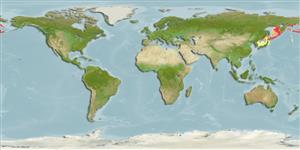Elasmobranchii (sharks and rays) >
Rajiformes (Skates and rays) >
Arhynchobatidae (Softnose skates)
Etymology: Bathyraja: Greek, bathys = deep + Latin, raja, -ae = a ray (Raja sp) (Ref. 45335); minispinosa: Name from the Latin adjective 'minispinosa' meaning full of small thorns; referring to the dorsal side of the disc with many minute fine prickles which are smooth to the touch (Ref. 75535).
Environment: milieu / climate zone / depth range / distribution range
Ecology
Marine; demersal; depth range 150 - 1420 m (Ref. 50550). Temperate
North Pacific: Sea of Okhotsk off Abashiri, Japan to the Kamchatka Peninsula and the Bering Sea.
Size / Weight / Age
Maturity: Lm ? range ? - ? cm
Max length : 82.5 cm TL male/unsexed; (Ref. 96339)
Short description
Identification keys | Morphology | Morphometrics
This species is distinguished from its congeners in Bathyraja in having a whitish area along the inner margin of eyes; dorsal side of disc with minute fine prickles; pointed clasper with a pseudosiphon-like groove; dense, minute prickles covering smaller egg capsule (Ref. 75535).
Juveniles feed mainly on amphipods, adults feed on crabs and fish (Ref. 27640). Oviparous. Distinct pairing with embrace. Young may tend to follow large objects, such as their mother (Ref. 205). Eggs are oblong capsules with stiff pointed horns at the corners deposited in sandy or muddy flats (Ref. 205). Egg capsules are 7.6 cm long and 5.5 cm wide (Ref. 41249).
Life cycle and mating behavior
Maturities | Reproduction | Spawnings | Egg(s) | Fecundities | Larvae
Oviparous, paired eggs are laid. Embryos feed solely on yolk (Ref. 50449). Distinct pairing with embrace. Young may tend to follow large objects, such as their mother (Ref. 205). Eggs have horn-like projections on the shell (Ref. 205).
McEachran, J.D. and K.A. Dunn, 1998. Phylogenetic analysis of skates, a morphologically conservative clade of elasmobranchs (Chondrichthyes: Rajidae). Copeia 1998(2):271-290. (Ref. 27314)
IUCN Red List Status (Ref. 130435)
Threat to humans
Harmless
Human uses
Tools
Special reports
Download XML
Internet sources
Estimates based on models
Preferred temperature (Ref.
123201): 0.8 - 3.6, mean 1.8 °C (based on 126 cells).
Phylogenetic diversity index (Ref.
82804): PD
50 = 0.5000 [Uniqueness, from 0.5 = low to 2.0 = high].
Bayesian length-weight: a=0.00468 (0.00303 - 0.00721), b=3.05 (2.92 - 3.18), in cm total length, based on LWR estimates for this species & Genus-body shape (Ref.
93245).
Trophic level (Ref.
69278): 3.8 ±0.66 se; based on food items.
Resilience (Ref.
120179): Low, minimum population doubling time 4.5 - 14 years (Fec assumed to be <100).
Fishing Vulnerability (Ref.
59153): Moderate to high vulnerability (53 of 100).
